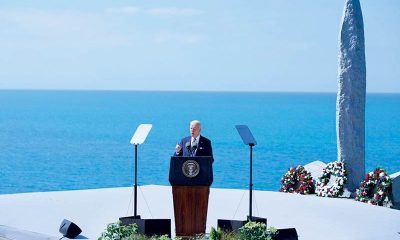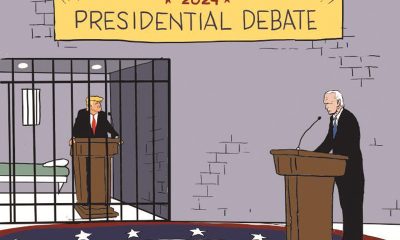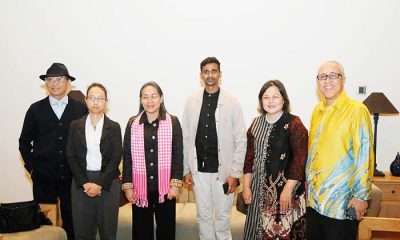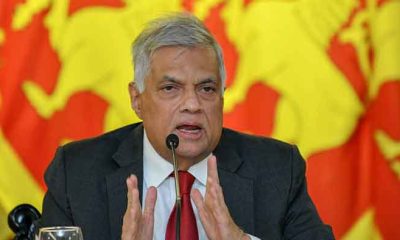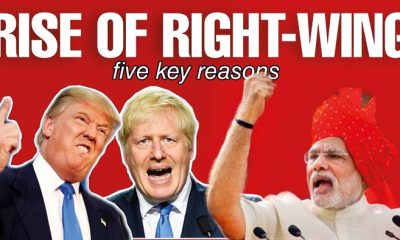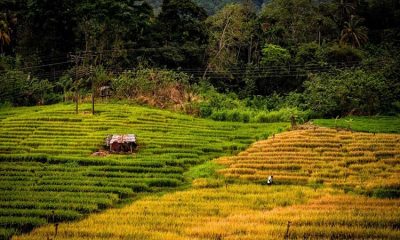Features
Wisdom in Political Insights: My talk with Mahathir Mohamad

by Nilantha Ilangamuwa
Before we dived into the world of politics, I was eager to learn how he managed his style and which fundamentals he followed to pursue the goal of the common good. I had the privilege of talking via zoom with none other than Mahathir Mohamad, a major force behind Malaysia’s take-off. Before he became an icon in the political arena, Mahathir was a physician, a graduate of the reputed King Edward VII College of Medicine in Singapore. I sought his wisdom on the enduring principles that guide a life and a profession.
As he leaned forward, his eyes reflecting the wisdom of a life well-lived, he shared, ‘If I may speak of my calling as a medical doctor, there is one cardinal principle that reigns supreme – the patient’s well-being. It’s not about profiting from others’ misfortunes but about tirelessly working towards healing. In my practice, I encountered countless individuals grappling with life’s myriad challenges.’
Dr. Mahathir bin Mohamad, a towering figure in Asian politics, held the office of Prime Minister for an astounding 24 years, from 1981 to 2003 and later from 2018 to 2020. He revealed the philosophy that has been his compass throughout this remarkable journey.
‘I lead a life of moderation, avoiding the extremes. For instance, when I eat, I do so in moderation, sufficient for sustenance. My mother’s wisdom echoes in my ears – when food becomes overly delightful, it’s time to stop. Moderation, in all aspects of life, is key. Never veer to the extremes,’ he advised.
Explaining his longevity, he shared, ‘I abstain from smoking and drinking, and I refrain from overindulgence in food. I consume just what is necessary for my vitality.’
Turning to the subject of knowledge, he harked back to his foundational beliefs. ‘Knowledge has eternally held sway. The ancient Egyptians didn’t erect pyramids through divine incantations, nor did the waters flow in the irrigation canals of the Indus Civilization by the ignorance of their laws. Knowledge has perpetually been the font of power and prosperity.’
Mahathir stands as one of the senior-most active politicians in Asia, if not the world, having seen the ascents and declines of countless leaders. When I asked about those whom he admired and those who presented challenges, he said:
‘There are leaders I greatly admire and tried to emulate in problem-solving. Take Nelson Mandela, who endured over 27 years in captivity yet emerged without a trace of bitterness, working hand in hand with his former captors to rebuild South Africa. He exemplified selflessness, prioritizing society over self. Leaders of this caliber endure suffering for the greater good of humanity.’
As for the more trying encounters he encountered during his tenure, he gracefully refrained from singling them out, understanding the potential consequences it could have on individuals and their families.
Q: ‘What, in your view, are the defining qualities of a true statesperson? How does one distinguish a genuine leader from someone who exploits racial or religious elements for power?’
A: ‘A true statesperson is one who places the world and society above personal interests. Even when faced with personal hurt, they remain committed to what is right and beneficial for the common citizen.’
Delving into the impact of nationalism on the process of nation-building, I sought Mahathir’s insights on the pivotal role of nationalism and how he harnessed this concept during his tenure as Malaysia’s leader, even in the face of contentious allegations regarding anti-Semitic rhetoric, favoritism towards the ethnic Malay majority, and the treatment of political opponents.
‘First and foremost, one must cultivate a deep love for one’s country. It’s the place where you were born, raised, and achieved your aspirations; essentially, it’s where your roots lie. This genuine love for one’s nation fosters a sincere desire to contribute to its development. When you hold authentic affection for your country, the thought of causing harm or tarnishing its reputation becomes inconceivable.
‘When individuals feel that their nation is capable of self-sustenance, it instills a sense of pride and responsibility. This sentiment, at its core, embodies the essence of true nationalism. Once a common goal is attained, there arises no inclination to harm the country.’
We then moved to Malaysia’s remarkable economic transformation during his leadership. In 1981, when he assumed office, Malaysia’s GDP stood at approximately 25 billion USD. Under his visionary stewardship, the nation’s GDP burgeoned to a staggering 110.2 billion USD. Many attribute this success to his leadership, despite its association with contentious policies. I asked what underlay this economic triumph.
‘To foster a nation’s growth, stability and peace are imperative. A nation beset by instability and racial tensions cannot thrive. In Malaysia, a diverse and multicultural country, my foremost task was to unite people from various ethnic and religious backgrounds to work together, thereby establishing social stability and peace. Once this foundation is laid, the path is paved for economic growth, attracting new investments, and enabling individuals from diverse fields to flourish professionally.’
On his interactions with Sri Lanka, a country he had visited many times, I couldn’t help but pose a question about how we went wrong compared to Malaysia and Singapore.
Q: ‘You’ve made several visits to Sri Lanka, with your last visit in 2014, when you launched various development projects. At one point, you and your political rival, the late Lee Kuan Yew, emphasized the importance of learning from Sri Lanka’s successes. However, today, Sri Lanka’s path diverges significantly from that of Malaysia and Singapore. What, in your opinion, went wrong in Sri Lanka?’
A: A country’s progress is greatly contingent on its leadership. If the leader is inept, unfocused on authentic national development, or lacks an understanding of what development model suits their nation, regression is inevitable. History is replete with examples of countries that once shone brightly but have since faded.
‘Some nations falter when leaders prioritize personal gain and well-being over the welfare of the nation. Consequently, regression becomes their destiny. The history of every country exhibits cycles of ups and downs, and change is an intrinsic part of a nation’s journey.’
Mahathir’s spirited political debates with the late Lee Kuan Yew of Singapore remain indelibly etched in the annals of history. In a book titled ‘Conversations with Mahathir Mohamad,’ he offered a glimpse into the subject saying, ‘The fact remains that he is a mayor of Singapore. This is something he doesn’t like. He wants to be big, you see, and he feels that we took away his opportunity to lead a real country.’ Conversely, Lee Kuan Yew referred to Mahathir as ‘a thoroughly destructive force. He is a very smart man, but his mentality is still stuck in the 1970s.’
I probed him on those years of political rivalry and the intricacies of their relationship. he recounted, ‘When Singapore merged with Malaysia, it was a nation struggling to find its feet. Emerging from British rule, it had encountered its share of challenges during that period. Lee Kuan Yew saw this merger as his chance to become the Prime Minister of Malaysia. In Malaysia, he believed he could hold a substantial role, akin to a real Prime Minister, whereas in Singapore, he would be more like a mayor.
‘However, he soon discovered that Malaysia was not as welcoming as he had hoped. Ultimately, Malaysia expelled Singapore due to the disruptive political climate he had introduced. The then Prime Minister, Tunku Abdul Rahman, decided that Singapore should no longer be part of Malaysia. Singapore, of course, thrived after its expulsion, but at that moment, Lee Kuan Yew believed he had lost a significant opportunity to become a Prime Minister, which is why he shed tears.’
Responding to Lee Kuan Yew’s characterization of him, he countered, ‘Well, everyone is entitled to their perspective. He viewed me as orthodox, and perhaps he wasn’t entirely wrong. I was deeply concerned about racial relations in Malaysia. We have three major ethnic groups, but their achievements were not on par. The Chinese community had made significant strides and seized opportunities post-independence, while the Malays struggled in business, despite being afforded similar opportunities. This disparity was a persistent obstacle to our nation’s development. My aim was to eliminate these disparities and drive the country toward true development. To some, my methods might have seemed orthodox, but my focus was squarely on bridging the ethnic divides.’
I inquired about reports suggesting that during his tenure as Prime Minister of Malaysia, he had made efforts to secure ASEAN membership for Sri Lanka but faced opposition from certain political quarters in other countries. I asked him to confirm the accuracy of these reports.
‘Indeed, ASEAN is a remarkable success story in the realm of regional cooperation, notably for its ability to reject war in the region for over six decades. While many other nations expressed interest in joining ASEAN, certain factors, such as geographical location, posed obstacles to their inclusion. The organization’s concern was that if it expanded too rapidly, it might become unwieldy. I believed Sri Lanka was a suitable candidate for ASEAN membership, transcending geographical differences. However, other member nations were hesitant to extend the invitation.’
Next we got on to his thoughts on the development of secondary leadership. Often, exceptional leaders, when they depart, leave a void that can lead to political polarization and division. I queried how he, drawing from his decades of political experience and wisdom, fostered secondary leadership in Malaysia and navigated the challenges along the way.
‘When you assume the role of Prime Minister, you wield immense power, and that power can be either a tool for personal gain or an instrument for national progress. I was acutely aware that if I used that power for personal purposes, I would tarnish my legacy and leave a stain on the nation’s history. Instead, I chose to focus on the nation’s development. For me, the enduring satisfaction came from witnessing the country’s growth. That was the only reward I sought, and it was the reward I received from the world through recognition of Malaysia’s development.’
‘During my first term as Prime Minister, which lasted for over 20 years, I realized that it was a lengthy tenure, and I was already in my seventies. I firmly believed that the key to our nation’s progress lay in nurturing a new generation of leaders. I advocated the notion that developing the nation was a prerequisite for individual growth. I encouraged my successors to follow the same path, with the aim of propelling Malaysia to developed nation status. However, once I stepped down from office, subsequent leaders pursued different agendas. They wrongly believed that during my tenure, I had misappropriated government funds, despite the facts pointing to the contrary. Consequently, they began to wield their power for personal interests, derailing the path we had charted since the early ’80s. This regression halted Malaysia’s growth.
This prompted me to re-enter politics. Subsequently, I once again assumed the role of Prime Minister. However, the political landscape had transformed. Certain political parties resorted to exploiting religious and ethnic divisions to disrupt the newly formed government, triggering a series of political crises and eroding political stability. In the past 60 years, we had experienced only four changes in government. However, after my departure in 2020, four different governments came to power, further exacerbating political and social instability.’
Curious about external influences, I asked if external parties played a role in perpetuating this instability. Dr. Mahathir acknowledged the possibility of some external elements but characterized the situation as a complex political crisis that would require time and effort to resolve.
Finally, I posed the question: What he considered to be his biggest mistake during his tenure as the longest-serving ruler in modern Malaysian history. He contemplated deeply and replied, ‘I believe that stepping down from the position of Prime Minister was a significant mistake. However, had I not done so, people would not have had the opportunity to see what kind of government they would get in my absence. It’s often during challenging times that we truly appreciate the value of a nation’s well-being. We must undergo difficult periods to realize that the prosperity of a country is not a permanent state.’
I finally sought Dr. Mahathir’s thoughts on the pressing issues that confront our world today. In this era of multiple crises – from global health emergencies to supply chain disruptions, debates surrounding multi-polarism versus Western hegemony, the rise of the Global South, and China’s aspirations to superpower status – I asked him to convey a message to the global community, one that promotes equity and dignity for all of humanity.
‘In the past, when conflicts arose among small principalities, strong leaders would unite these territories into larger nations, steering them towards development. That was the historical narrative. However, our world has changed significantly. Today, due to the ease of communication, we are not just neighbors with our immediate neighboring countries but with the entire world. This closeness brings with it shared challenges that demand a collective approach. In essence, we require a form of global governance.
‘We have seen attempts at this before, such as the League of Nations, which ultimately faltered. Then came the era of the United Nations, which, unfortunately, is also facing challenges. The United Nations, with its five veto-wielding powers, can sometimes be stymied by the interests of a few. Therefore, it is imperative for the world to forge a unified movement to tackle common global issues, including pandemics, the consequences of climate change, the growing global population, and more. Just as small principalities once came together to form nation-states, now nation-states must unite to create a global governance structure capable of addressing these shared problems.’
As a parting thought, Dr. Mahathir turned his attention to the ongoing conflict in Ukraine. He observed, ‘Europeans still seem to contemplate resolving international conflicts through wars. They had allied with the Russians during World War II to combat Germany, and together they defeated Germany. However, immediately after victory, they designated Russia as a new enemy, leading to the establishment of NATO, focused squarely on Russia.
In response, Russia formed the Warsaw Pact, sparking a prolonged Cold War, which was a considerable waste of resources and time. When Russia eventually decided to dissolve the Warsaw Pact, NATO took a different path. Instead of dismantling itself, it bolstered its capabilities and invited former Warsaw Pact members to join, all directed against Russia. This inevitably fueled a series of conflicts, with the Ukraine conflict being a part of this larger narrative.’
He concluded with a resounding call for change, stating, ‘While NATO nations provide support to the war in Ukraine, it is the Ukrainian people who are fighting and suffering. Allowing Ukrainians to endure this conflict, with lives lost and their nation in ruins, is untenable. The mindset of resolving disputes through warfare must come to an end.’
Features
When water becomes the weapon

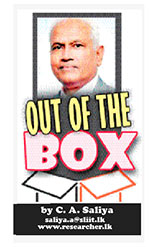 On the morning of November 28, 2025, Cyclone Ditwah made an unremarkable entrance, meteorologically speaking. With winds barely scraping 75 km/h, it was classified as merely a “Cyclonic Storm” by the India Meteorological Department. No dramatic satellite spiral. No apocalyptic wind speeds. Just a modest weather system forming unusually close to the equator, south of Sri Lanka.
On the morning of November 28, 2025, Cyclone Ditwah made an unremarkable entrance, meteorologically speaking. With winds barely scraping 75 km/h, it was classified as merely a “Cyclonic Storm” by the India Meteorological Department. No dramatic satellite spiral. No apocalyptic wind speeds. Just a modest weather system forming unusually close to the equator, south of Sri Lanka.
By December’s second week, the numbers told a story of national reckoning: over 650 lives lost, 2.3 million people affected, roughly one in ten Sri Lankans, and economic losses estimated between $6-7 billion. To put that in perspective, the damage bill equals roughly 3-5% of the country’s entire GDP, exceeding the combined annual budgets for healthcare and education. It became Sri Lanka’s deadliest natural disaster since the 2004 tsunami.
The Hydrology of Horror
The answer lies not in wind speed but in water volume. In just 24 hours on 28 November, hydrologists estimate that approximately 13 billion cubic meters of rain fell across Sri Lanka, roughly 10% of the island’s average annual rainfall compressed into a single day. Some areas recorded over 300-400mm in that period. To visualise the scale: the discharge rate approached 150,000 cubic meters per second, comparable to the Amazon River at peak flow, but concentrated on an island 100 times smaller than the Amazon basin.
The soil, already saturated from previous monsoon rains, couldn’t absorb this deluge. Nearly everything ran off. The Kelani, Mahaweli, and Deduru Oya river systems overflowed simultaneously. Reservoirs like Kala Wewa and Rajanganaya had to release massive volumes to prevent catastrophic dam failures, which only accelerated downstream flooding.
Where Development Met Disaster
The human toll concentrated in two distinct geographies, each revealing different failures.
In the Central Highlands, Kandy, Badulla, Nuwara Eliya, Matale, landslides became the primary killer. The National Building Research Organisation documented over 1,200 landslides in the first week alone, with 60% in the hill country. These weren’t random geological events; they were the culmination of decades of environmental degradation. Colonial-era tea and rubber plantations stripped highland forests, increasing soil erosion and landslide susceptibility. Today, deforestation continues alongside unregulated hillside construction that ignores slope stability.
The communities most vulnerable? The Malaiyaha Tamil plantation workers, descendants of indentured labourers brought from South India by the British. Living in cramped “line rooms” on remote estates, they faced both the highest mortality rates and the greatest difficulty accessing rescue services. Many settlements remained cut off for days.
Meanwhile, in the Western Province urban basin, Colombo, Gampaha, Kolonnawa, the Kelani River’s overflow displaced hundreds of thousands. Kolonnawa, where approximately 70% of the area sits below sea level, became an inland sea. Urban planning failures compounded the crisis: wetlands filled in for development, drainage systems inadequate for changing rainfall patterns, and encroachments on flood retention areas all transformed what should have been manageable flooding into mass displacement.
The Economic Aftershock
By 03 December, when the cyclone had degraded to a remnant low, the physical damage inventory read like a national infrastructure audit gone catastrophic:
UNDP’s geospatial analysis revealed exposure: about 720,000 buildings, 16,000 km of roads, 278 km of rail, and 480 bridges in flooded zones. This represents infrastructure that underpins the daily functioning of 82-84% of the national economy.
The agricultural sector faces multi-season impacts. The cyclone struck during the Maha season, Sri Lanka’s major cultivation period, when approximately 563,950 hectares had just been sown. Government data confirms 108,000 hectares of rice paddies destroyed, 11,000 hectares of other field crops lost, and 6,143 hectares of vegetables wiped out. The tea industry, while less damaged than food crops, projects a 35% output decline, threatening $1.29 billion in annual export revenue.
Supply chains broke. Cold storage facilities failed. Food prices spiked in urban markets, hitting hardest the rural households that produce the food, communities where poverty rates had already doubled to 25% following the recent economic crisis.
The Hidden Costs: Externalities
Yet the most consequential damage doesn’t appear in economic loss estimates. These are what economists call externalities, costs that elude conventional accounting but compound human suffering.
Environmental externalities : Over 1,900 landslides in protected landscapes like the Knuckles Range uprooted forest canopies, buried understory vegetation, and clogged streams with debris. These biodiversity losses carry long-term ecological and hydrological costs, habitat fragmentation, compromised watershed function, and increased vulnerability to future slope failures.
Social externalities: Overcrowded shelters created conditions for disease transmission that WHO warned could trigger epidemics of water-, food-, and vector-borne illnesses. The unpaid care work, predominantly shouldered by women, in these camps represents invisible labour sustaining survival. Gender-based violence risks escalate in displacement settings yet receive minimal systematic response. For informal workers and micro-enterprises, the loss of tools, inventory, and premises imposes multi-year setbacks and debt burdens that poverty measurements will capture only later, if at all.
Governance externalities: The first week exposed critical gaps. Multilingual warning systems failed, Coordination between agencies remained siloed. Data-sharing between the Disaster Management Centre, Meteorology Department, and local authorities proved inadequate for real-time decision-making. These aren’t technical failures; they’re symptoms of institutional capacity eroded by years of budget constraints, hiring freezes, and deferred maintenance.
Why This Cyclone Was Different
Climate scientists studying Ditwah’s behaviour note concerning anomalies. It formed unusually close to the equator and maintained intensity far longer than expected after landfall. While Sri Lanka has experienced at least 16 cyclones since 2000, these were typically mild. Ditwah’s behaviour suggests something shifting in regional climate patterns.
Sri Lanka ranks high on the Global Climate Risk Index, yet 81.2% of the population lacks adaptive capacity for disasters. This isn’t a knowledge gap; it’s a resource gap. The country’s Meteorology Department lacks sufficient Doppler radars for precise forecasting. Rescue helicopters are ageing and maintenance are deferred. Urban drainage hasn’t been upgraded to handle changing rainfall patterns. Reservoir management protocols were designed for historical rainfall distributions that no longer apply.
The convergence proved deadly: a climate system behaving unpredictably met infrastructure built for a different era, governed by institutions weakened by austerity, in a landscape where unregulated development had systematically eroded natural defences.

Sources: WHO, UNICEF, UNDP, Sri Lanka Disaster Management Centre, UN OCHA, The Diplomat, Al Jazeera,
The Recovery Crossroads
With foreign reserves barely matching the reconstruction bill, Sri Lanka faces constrained choices. An IMF consideration of an additional $200 million on top of a scheduled tranche offers partial relief, but the fiscal envelope, shaped by ongoing debt restructuring and austerity commitments, forces brutal prioritisation.
The temptation will be “like-for-like” rebuilds replace what washed away with similar structures in the same locations. This would be the fastest path back to normalcy and the surest route to repeat disaster. The alternative, what disaster planners call “Build Back Better”, requires different investments:
* Targeted livelihood support for the most vulnerable: Cash grants and working capital for fisherfolk, smallholders, and women-led enterprises, coupled with temporary employment in debris clearance and ecosystem restoration projects.
* Resilient infrastructure: Enforce flood-resistant building codes, elevate power substations, create backup power routes, and use satellite monitoring for landslide-prone areas.
* Rapid disaster payments: Automatically scale up cash aid through existing social registries, with mobile transfers and safeguards for women and disabled people.
* Insurance for disasters: Create a national emergency fund triggered by rainfall and wind data, plus affordable microinsurance for fishers and farmers.
* Restore natural defences: Replant mangroves and wetlands, dredge rivers, and strictly enforce coastal building restrictions, relocating communities where necessary.
The Reckoning
The answers are uncomfortable. Decades of prioritising economic corridors over drainage systems. Colonial land-use patterns perpetuated into the present. Wetlands sacrificed for development. Budget cuts to the institutions responsible for warnings and response. Building codes are unenforced. Early warning systems are under-resourced. Marginalised communities settled in the riskiest locations with the least support.
These aren’t acts of nature; they’re choices. Cyclone Ditwah made those choices visible in 13 billion cubic meters of water with nowhere safe to flow.
As floodwaters recede and reconstruction begins, Sri Lanka stands at a crossroads. One path leads back to the fragilities that made this disaster inevitable. The other, more expensive, more complex, more uncomfortable, leads to systems designed not to withstand the last disaster but to anticipate the next ones.
In an era of warming oceans and intensifying extremes, treating Ditwah as a once-in-a-generation anomaly would be the most dangerous assumption of all.
(The writer, a senior Chartered Accountant and professional banker, is Professor at SLIIT, Malabe. The views and opinions expressed in this article are personal.)
Features
Revival of Innovative systems for reservoir operation and flood forecasting
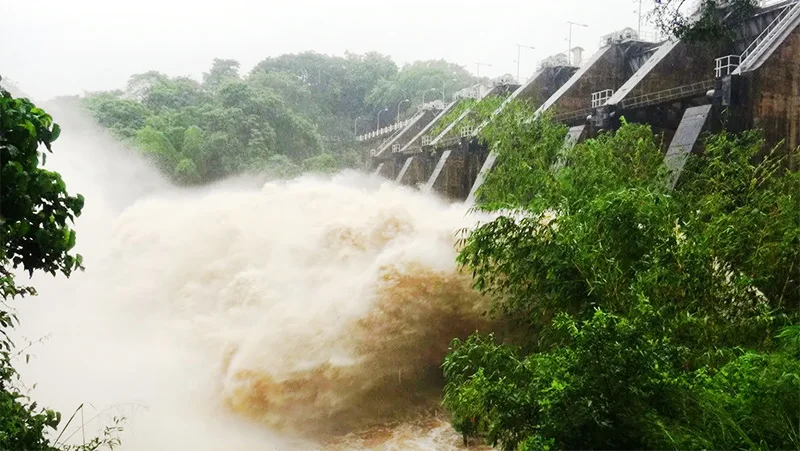
Most reservoirs in Sri Lanka are agriculture and hydropower dominated. Reservoir operators are often unwilling to acknowledge the flood detention capability of major reservoirs during the onset of monsoons. Deviating from the traditional priority for food production and hydropower development, it is time to reorient the operational approach of major reservoir operators under extreme events, where flood control becomes a vital function. While admitting that total elimination of flood impacts is not technically feasible, the impacts can be reduced by the efficient operation of reservoirs and effective early warning systems.
At the very outset, I would like to mention that the contents in this article are based on my personal experience in the Irrigation Department (ID), and there is no intention to disrespect their contributions during the most recent flood event. The objective is to improve the efficiency and the capability of the human resources available in the ID and other relevant institutions to better respond to future flood disasters.
Reservoir operation and flood forecasting
Reservoir management is an important aspect of water management, as water storage and release are crucial for managing floods and droughts. Several numerical models and guidelines have already been introduced to the ID and MASL during numerous training programs for reservoir management and forecasting of inflows.
This article highlights expectations of engineering professionals and discusses a framework for predicting reservoir inflows from its catchment by using the measured rainfall during the previous few days. Crucially, opening the reservoir gates must be timed to match the estimated inflow.
Similarly, rainfall-runoff relationships had been demonstrated and necessary training was provided to selected engineers during the past to make a quantitative (not qualitative) forecast of river water levels at downstream locations, based on the observed rainfall in the upstream catchment.
Already available information and technology
Furthermore, this article highlights the already available technology and addresses certain misinformation provided to the mass media by some professionals during recent discussions. These discrepancies are primarily related to the opening of reservoir gates and flood forecasting.
A. Assessing the 2025 Flood Magnitude
It is not logically sound to claim that the 2025 flood in the Kelani basin was the highest flood experienced historically. While, in terms of flood damage, it was probably the worst flood experienced due to rapid urbanisation in the lower Kelani basin. We have experienced many critical and dangerous floods in the past by hydraulic definition in the Kelani Ganga.
Historical water levels recorded at the Nagalagam Street gauge illustrate this point: (See Table)

In view of the above data, the highest water level recorded at the Nagalagam river gauge during the 2025 flood was 8.5 ft. This was a major flood, but not a critical or dangerous flood by definition.
B. Adherence to Reservoir Standing Orders
According to the standing orders of the ID, water levels in major reservoirs must be kept below the Full Supply Level (FSL) during the Northeast (NE) monsoon season (from October to March) until the end of December. According to my recollection, this operational height is 1.0m below the FSL. Therefore, maintaining a reservoir below the FSL during this period is not a new practice; it explicitly serves the dual purpose of dam safety and flood detention for the downstream areas.
C. Gate Operation Methodology
When a reservoir is reaching the FSL, the daily operation of gates is expected to be managed so that the inflow of water from the catchment rainfall is equal to the outflow through the spill gates (Inflow * Outflow). The methodology for estimating both the catchment inflow and the gate outflow is based on very simple formulas, which have been previously taught to the technical officers and engineers engaged in field operations.
D. Advanced Forecasting Capabilities
Sophisticated numerical models for rainfall-runoff relationships are available and known to subject specialists of the ID through the training provided over the last 40 years. For major reservoirs, the engineers in charge of field operations could be trained to estimate daily inflows to the reservoirs, especially in cases where the simple formulas mentioned in section C are not adequate.
Design concept of reservoir flood gates
Regarding the provision of reservoir spill gates, one must be mindful of the underlying principles of probability. Major reservoir spillways are designed for very high return periods, such as 1,000 and 10,000 years. If the spillway gates are opened fully when a reservoir is at full capacity, this can produce an artificial flood of a very large magnitude. A flood of such magnitude cannot occur under natural conditions. Therefore, reservoir operators must be mindful in this regard to avoid any artificial flood creation.
In reality, reservoir spillways are often designed for the sole safety of the reservoir structure, often compromising the safety of the downstream population. This design concept was promoted by foreign funding agencies in recent times to safeguard their investment for dams. Consequently, the discharge capacities of these spill gates significantly exceed the natural carrying capacity of river downstream. This design criterion requires serious consideration by future designers and policymakers.
Undesirable gate openings
The public often asks a basic question regarding flood hazards in a river system with reservoirs: Why is flooding more prominent downstream of reservoirs compared to the period before they were built? This concern is justifiable based on the following incidents.
For instance, why do Magama in Tissamaharama face flood threats after the construction of the massive Kirindi Oya reservoir? Similarly, why does Ambalantota flood after the construction of Udawalawe Reservoir? Furthermore, why is Molkawa in the Kalutara District area getting flooded so often after the construction of Kukule reservoir?
These situations exist in several other river basins too. Engineers must therefore be mindful of the need to strictly control the operation of reservoir gates by their field staff. The actual field situation can sometimes deviate significantly from the theoretical technology discussed in air- conditioned rooms. Due to this potential discrepancy, it is necessary to examine whether gate operators are strictly adhering to the operational guidelines, as gate operation currently relies too much on the discretion of the operator at the site.
In 2003, there was severe flood damage below Kaudulla reservoir in Polonnaruwa. I was instructed to find out the reason for this flooding by the then Minister of Mahaweli & Irrigation. During my field inspection, I found that the daily rainfall in the area had not exceeded 100mm, yet the downstream flood damage was unbelievable. I was certain that 100mm of rainfall could not create a flood of that magnitude. Further examination suggested that this was not a natural flood, but was created by the excessive release of water from the radial gates of the Kaudulla reservoir. There are several other similar incidents and those are beyond the space available for this document.
Revival of Innovative systems
It may be surprising to note the high quality of real-time flood forecasts issued by the ID for the Kelani River in the late 1980s and early 1990s. This was achieved despite the lack of modern computational skills and advanced communication systems. At that time, for instance, mobile phones were non-existent. Forecasts were issued primarily via the Sri Lanka Broadcasting Corporation (SLBC )in news bulletins.
A few examples of flood warning issued during the past available in official records of the ID are given below:
Forecast issued at 6th June 1989 at 5.00 PM
“The water level at Nagalagam street river gauge was at 9 ft 0 inches at 5.0 PM. This is 1.0 ft above the major flood level. Water level is likely to rise further, but not likely to endanger the Kelani flood bund”.
Eng. NGR. De Silva, Director Irrigation
Forecast issued at 30th Oct 1991 at 6.00 PM
“The water level at Nagalagam street river gauge was at 3 ft 3 inches at 6.0 PM. The water level likely to rise further during the next 24 hours, but will not exceed 5.0 ft.”
Eng. K.Yoganathan, Director Irrigation
Forecast issued at 6th June 1993 at 10.00 AM:
“The water level at Nagalagam street river gauge was at 4 ft 6 inches last night. The water level will not go above 5.0 ft within the next 24 hours.”
Eng. K.Yoganathan, Director Irrigation
Forecast issued at 8th June 1993 at 9.00 AM:
“The water level at Nagalagam Street River gauge was at 4 ft 6 inches at 7.00 AM. The water level will remain above 4.0 ft for the next 12 hours and this level will go below 4.0 ft in the night.
The water level is not expected to rise within next 24 hours.”
Eng.WNM Boteju,Director of Irrigation
Conclusion
Had this technology been consistently and effectively adopted, we could have significantly reduced the number of deaths and mitigated the unprecedented damage to our national infrastructure. The critical question then arises: Why is this known, established flood forecasting technology, already demonstrated by Sri Lankan authorities, not being put into practice during recent disasters? I will leave the answer to this question for social scientists, administrators and politicians in Sri Lanka.
Features
Rebuilding Sri Lanka for the long term
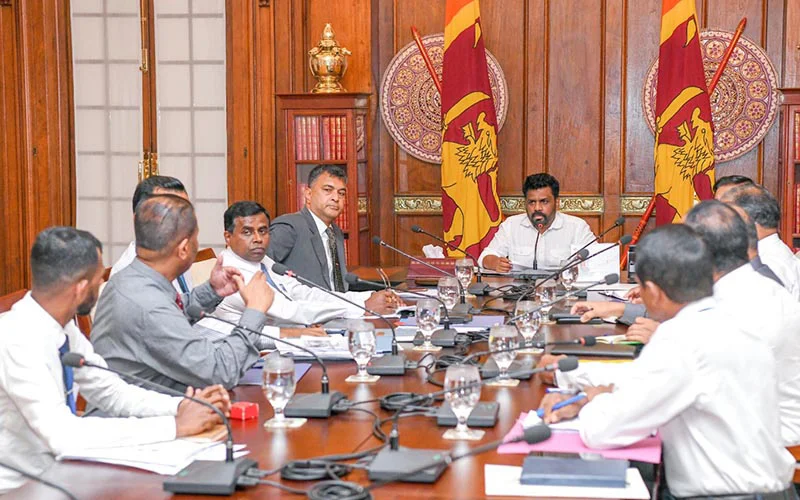
The government is rebuilding the cyclone-devastated lives, livelihoods and infrastructure in the country after the immense destruction caused by Cyclone Ditwah. President Anura Kumara Dissanayake has been providing exceptional leadership by going into the cyclone affected communities in person, to mingle directly with the people there and to offer encouragement and hope to them. A President who can be in the midst of people when they are suffering and in sorrow is a true leader. In a political culture where leaders have often been distant from the everyday hardships of ordinary people, this visible presence would have a reassuring psychological effect.
The international community appears to be comfortable with the government and has been united in giving it immediate support. Whether it be Indian and US helicopters that provided essential airlift capacity or cargo loads of relief material that have come from numerous countries, or funds raised from the people of tiny Maldives, the support has given Sri Lankans the sense of being a part of the world family. The speed and breadth of this response has contrasted sharply with the isolation Sri Lanka experienced during some of the darker moments of its recent past.
There is no better indicator of the international goodwill to Sri Lanka as in the personal donations for emergency relief that have been made by members of the diplomatic corps in Sri Lanka. Such gestures go beyond formal diplomacy and suggest a degree of personal confidence in the direction in which the country is moving. The office of the UN representative in Sri Lanka has now taken the initiative to launch a campaign for longer term support, signalling that emergency assistance can be a bridge to sustained engagement rather than a one-off intervention.
Balanced Statement
In a world that has turned increasingly to looking after narrow national interests rather than broad common interests, Sri Lanka appears to have found a way to obtain the support of all countries. It has received support from countries that are openly rivals to each other. This rare convergence reflects a perception that Sri Lanka is not seeking to play one power against another, and balancing them, but rather to rebuild itself on the basis of stability, inclusiveness and responsible governance.
An excerpt from an interview that President Dissanayake gave to the US based Newsweek magazine is worth reproducing. In just one paragraph he has summed up Sri Lankan foreign policy that can last the test of time. A question Newsweek put to the president was: “Sri Lanka sits at the crossroads of Chinese built infrastructure, Indian regional influence and US economic leverage. To what extent does Sri Lanka truly retain strategic autonomy, and how do you balance these relationships?”
The president replied: “India is Sri Lanka’s closest neighbour, separated by about 24 km of ocean. We have a civilisational connection with India. There is hardly any aspect of life in Sri Lanka that is not connected to India in some way or another. India has been the first responder whenever Sri Lanka has faced difficulty. India is also our largest trading partner, our largest source of tourism and a significant investor in Sri Lanka. China is also a close and strategic partner. We have a long historic relationship—both at the state level and at a political party level. Our trade, investment and infrastructure partnership is very strong. The United States and Sri Lanka also have deep and multifaceted ties. The US is our largest market. We also have shared democratic values and a commitment to a rules-based order. We don’t look at our relations with these important countries as balancing. Each of our relationships is important to us. We work with everyone, but always with a single purpose – a better world for Sri Lankans, in a better world for all.”
Wider Issues
The President’s articulation of foreign relations, especially the underlying theme of working with everyone for the wellbeing of all, resonates strongly in the context of the present crisis. The willingness of all major partners to assist Sri Lanka simultaneously suggests that goodwill generated through effective disaster response can translate into broader political and diplomatic space. Within the country, the government has been successful in calling for and in obtaining the support of civil society which has an ethos of filling in gaps by seeking the inclusion of marginalised groups and communities who may be left out of the mainstream of development.
Civil society organisations have historically played a crucial role in Sri Lanka during times of crisis, often reaching communities that state institutions struggle to access. Following a meeting with CSOs, at which the president requested their support and assured them of their freedom to choose, the CSOs mobilised in all flood affected parts of the country, many of them as part of a CSO Collective for Emergency Response. An important initiative was to undertake the task of ascertaining the needs of the cyclone affected people. Volunteers from a number of civil society groups fanned out throughout the country to collect the necessary information. This effort helped to ground relief efforts in real needs rather than assumptions, reducing duplication and ensuring that assistance reached those most affected.
The priority that the government is currently having to give to post-cyclone rebuilding must not distract it from giving priority attention to dealing with postwar issues. The government has the ability and value-system to resolve other national problems. Resolving issues of post disaster rebuilding in the aftermath of the cyclone have commonalities in relation to the civil war that ended in 2009. The failure of successive governments to address those issues has prompted the international community to continuously question and find fault with Sri Lanka at the UN. This history has weighed heavily on Sri Lanka’s international standing and has limited its ability to fully leverage external support.
Required Urgency
At a time when the international community is demonstrating enormous goodwill to Sri Lanka, the lessons learnt from their own experiences, and the encouraging support they are giving Sri Lanka at present, can and must be utilised. The government under President Dissanayake has committed to a non-racist Sri Lanka in which all citizens will be treated equally. The experience of other countries, such as the UK, India, Switzerland, Canada and South Africa show that problems between ethnic communities also require inter community power sharing in the form of devolution of power. Countries that have succeeded in reconciling diversity with unity have done so by embedding inclusion into governance structures rather than treating it as a temporary concession.
Sri Lanka’s present moment of international goodwill provides a rare opening to learn from these experiences with the encouragement and support of its partners, including civil society which has shown its readiness to join hands with the government in working for the people’s wellbeing. The unresolved problems of land resettlement, compensation for lost lives and homes, finding the truth about missing persons continue to weigh heavily on the minds and psyche of people in the former war zones of the north and east even as they do so for the more recent victims of the cyclone.
Unresolved grievances do not disappear with time. They resurface periodically, often in moments of political transition or social stress, undermining national cohesion. The government needs to ensure sustainable solutions not only to climate related development, but also to ethnic peace and national reconciliation. The government needs to bring together the urgency of disaster recovery with the long-postponed task of political reform as done in the Indonesian province of Aceh in the aftermath of the 2004 tsunami for which it needs bipartisan political support. Doing so could transform a national tragedy into a turning point for long lasting unity and economic take-off.
by Jehan Perera
-

 Business6 days ago
Business6 days agoCabinet approves establishment of two 50 MW wind power stations in Mullikulum, Mannar region
-

 News7 days ago
News7 days agoGota ordered to give court evidence of life threats
-

 Features7 days ago
Features7 days agoCliff and Hank recreate golden era of ‘The Young Ones’
-

 Features7 days ago
Features7 days agoSri Lanka and Global Climate Emergency: Lessons of Cyclone Ditwah
-

 Editorial7 days ago
Editorial7 days agoExperience vs. Inexperience
-

 Features4 days ago
Features4 days agoWhy Sri Lanka Still Has No Doppler Radar – and Who Should Be Held Accountable
-
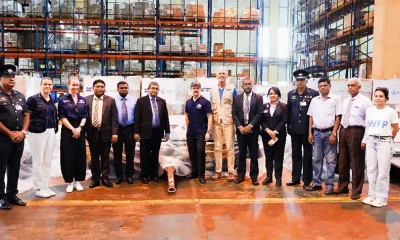
 News7 days ago
News7 days agoWFP scales up its emergency response in Sri Lanka
-

 Features6 days ago
Features6 days agoDitwah: A Country Tested, A People United


